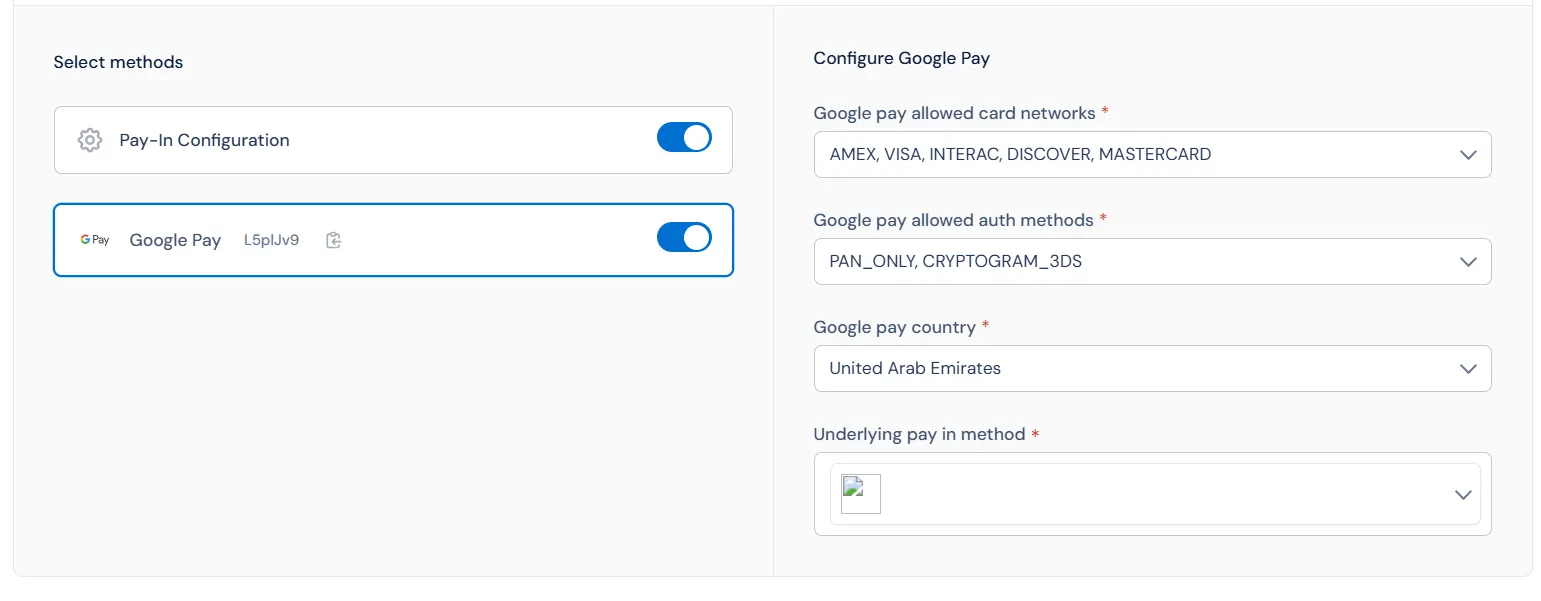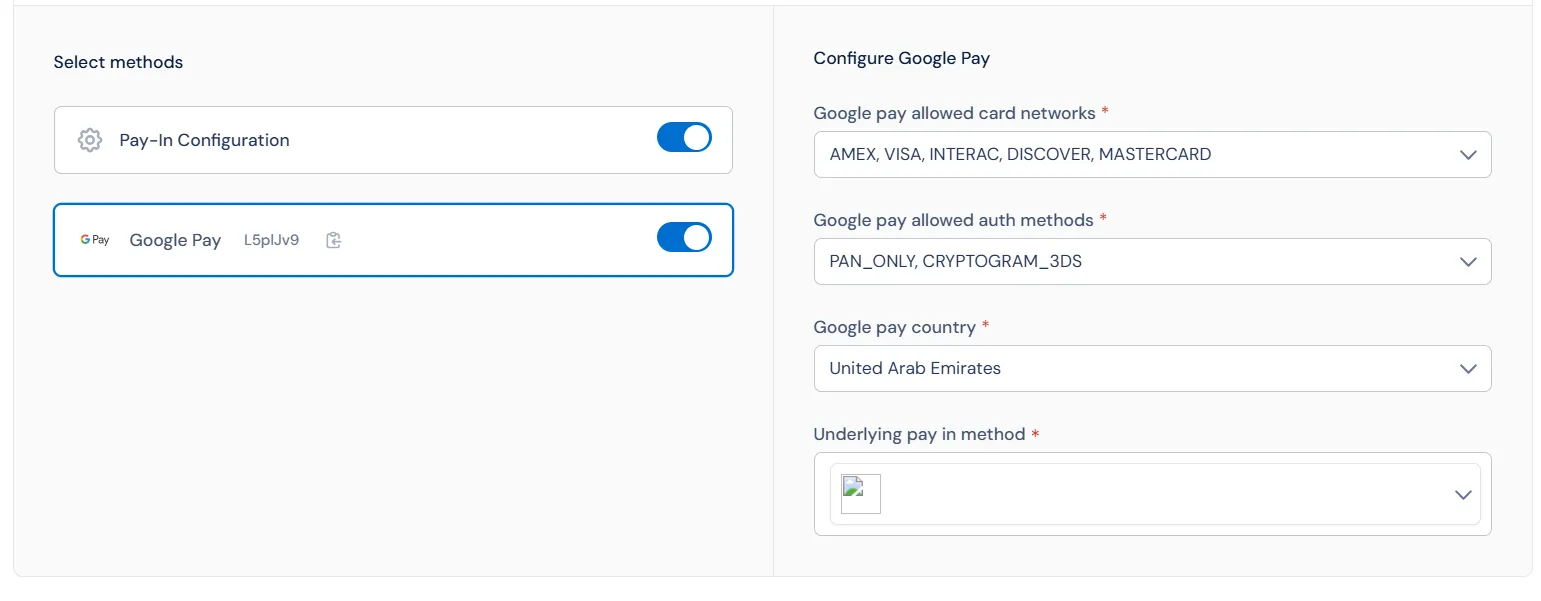Google Pay
Google Pay is a trademark of Google LLC.
Overview
MoneyHash's Google Pay integration enables you to:
- Accept payments using customers' saved cards in Google Pay
- Provide a seamless, native payment experience
Prerequisites
Before implementing Google Pay, ensure you have:
- A MoneyHash account with Google Pay enabled
- Your MoneyHash Account ID (used as
gatewayMerchantId) - A registered Google Pay merchant ID
- HTTPS enabled on your domain (required by Google Pay™)
Branding
You must follow Google’s brand guidelines when referencing Google Pay™:
- Ensure the first mention of Google Pay™ on every page includes the ™.
- Use only official Google Pay buttons and assets:
- Do not alter button colors, aspect ratio, or minimum size. Use dark or light button versions depending on your UI.
- Place the Google Pay button equal in size and prominence to other payment options.
Quick Start (For Developers)
// 1. Get config from MoneyHash
const { expressMethods } = await moneyHash.getMethods({ currency: '<currency'>, amount: '<amount>');
const googlePayMethod = expressPayMethods.find(method => method.id === 'GOOGLE_PAY');
const googlePayNativeData = googlePayMethod?.nativePayData;
// 2. Configure Google Pay button
button.paymentRequest = {
apiVersion: 2,
allowedPaymentMethods: [{
type: "CARD",
parameters: {
allowedAuthMethods: ["PAN_ONLY", "CRYPTOGRAM_3DS"],
allowedCardNetworks: ["VISA", "MASTERCARD"]
},
tokenizationSpecification: {
type: "PAYMENT_GATEWAY",
parameters: {
gateway: "moneyhash",
gatewayMerchantId: googlePayNativeData.gateway_merchant_id
}
}
}],
merchantInfo: {
merchantId: googlePayNativeData.merchant_id,
merchantName: googlePayNativeData.merchant_name,
},
transactionInfo: {
totalPrice: googlePayNativeData.amount,
currencyCode: googlePayNativeData.currency_code,
countryCode: googlePayNativeData.country_code
}
};
// 3. Handle token from Google Pay
button.addEventListener("loadpaymentdata", async (event) => {
const { paymentMethodData, email } = event.detail;
const paymentToken = paymentMethodData.tokenizationData.token;
const googlePayReceipt = {
receipt: paymentToken,
receiptBillingData: {
email,
},
};
await moneyHash.proceedWith({
type: "method",
id: "GOOGLE_PAY",
intentId,
});
// Submit the Google Pay payment token
const intentDetails = await moneyHash.submitPaymentReceipt({
intentId,
nativeReceiptData: googlePayReceipt,
});
console.log("Payment successful:", intentDetails);
});
Tokenization Specification & Integration Options
MoneyHash provides a tokenizationSpecification that allows merchants to process Google Pay™ transactions either via their own custom integration (Web / Android) or through MoneyHash’s SDK and hosted components.
{
"type": "PAYMENT_GATEWAY",
"parameters": {
"gateway": "moneyhash",
"gatewayMerchantId": "<your_moneyhash_account_id>"
}
}
We support two options for integration:
Option #1: Custom Integration Using SDKs
- Web: Use Google Pay Web SDK.
- Add
tokenizationSpecificationRetrieved from MoneyHash SDK - Follow branding requirements: Google Pay Web brand guidelines
- Add
- Android: Use Google Pay Android SDK.
- Add
tokenizationSpecificationRetrieved from MoneyHash SDK - Follow branding requirements: Google Pay Android brand guidelines
- Add
- Submit token via
submitPaymentReceiptto MoneyHash SDK.
Option #2: MoneyHash Hosted Page (Intent Embed)
If you prefer a faster setup, MoneyHash offers Hosted Payment Intent that can be embedded into Checkout Page.
- Enable Google Pay in MoneyHash Dashboard.
- Configure networks, auth methods, and country.
- The Embed handles most of the setup automatically.
- Token submission will be handled by Intent.
Dashboard Configuration
Below is an example of configuring Google Pay inside the MoneyHash Dashboard:

- Allowed card networks – select supported brands (Visa, Mastercard, Amex, Discover, JCB, Mada, etc.).
- Allowed auth methods – PAN_ONLY, CRYPTOGRAM_3DS.
- Google Pay country – country where payments will be processed.
- Underlying pay-in method – link to the correct provider.
Implementation Steps
Step 1: Install Google Pay SDK
Choose the implementation that best fits your project:
npm install @google-pay/button-element
npm install @google-pay/button-react
npm install @google-pay/button-angular
<script src="https://pay.google.com/gp/p/js/pay.js"></script>
Step 2: Get Available Payment Methods
First, retrieve the Google Pay configuration from MoneyHash:
// Get available payment methods including Google Pay data
const { expressMethods } = await moneyHash.getMethods({ currency: '<currency'>, amount: '<amount>');
const googlePayMethod = expressPayMethods.find(method => method.id === 'GOOGLE_PAY');
const googlePayNativeData = googlePayMethod?.nativePayData;
The googlePayNativeData object contains all the configuration you need:
gateway: Always "moneyhash"gateway_merchant_id: Your MoneyHash Account IDmerchant_id: Google Pay merchant IDmerchant_name: Your business nameamount: Payment amountcurrency_code: Currency codecountry_code: Country code
{
"currency_code": "<currency>",
"country_code": "..",
"amount": "<amount>",
"gateway": "moneyhash",
"gateway_merchant_id": "...",
"merchant_id": "....",
"merchant_name": "...",
"method_id": "...",
"allowed_card_networks": [
"AMEX",
"DISCOVER",
"INTERAC",
"JCB",
"MASTERCARD",
"VISA"
],
"allowed_card_auth_methods": [
"PAN_ONLY",
"CRYPTOGRAM_3DS"
]
}
Step 3: Configure Payment Request
import "@google-pay/button-element";
const button = document.querySelector("google-pay-button");
button.paymentRequest = {
apiVersion: 2,
apiVersionMinor: 0,
allowedPaymentMethods: [
{
type: "CARD",
parameters: {
allowedAuthMethods: ["PAN_ONLY", "CRYPTOGRAM_3DS"],
allowedCardNetworks: ["MASTERCARD", "VISA", "AMEX", "DISCOVER", "JCB"],
billingAddressRequired: true,
},
tokenizationSpecification: {
type: "PAYMENT_GATEWAY",
parameters: {
gateway: 'moneyhash', // MoneyHash gateway identifier
gatewayMerchantId: googlePayNativeData.gateway_merchant_id,
},
},
},
],
merchantInfo: {
merchantId: googlePayNativeData.merchant_id,
merchantName: googlePayNativeData.merchant_name,
},
transactionInfo: {
totalPriceStatus: "FINAL",
totalPriceLabel: "Total",
totalPrice: `${googlePayNativeData.amount}`,
currencyCode: googlePayNativeData.currency_code,
countryCode: googlePayNativeData.country_code,
},
emailRequired: true, // Collect customer email
};
import GooglePayButton from '@google-pay/button-react';
function CheckoutForm() {
return (
<GooglePayButton
environment="TEST" // Use "PRODUCTION" for live transactions
paymentRequest={{
apiVersion: 2,
apiVersionMinor: 0,
allowedPaymentMethods: [
{
type: 'CARD',
parameters: {
allowedAuthMethods: ['PAN_ONLY', 'CRYPTOGRAM_3DS'],
allowedCardNetworks: ["MASTERCARD", "VISA", "AMEX", "DISCOVER", "JCB"],
billingAddressRequired: true,
},
tokenizationSpecification: {
type: 'PAYMENT_GATEWAY',
parameters: {
gateway: 'moneyhash', // MoneyHash gateway identifier
gatewayMerchantId: googlePayNativeData.gateway_merchant_id,
},
},
},
],
merchantInfo: {
merchantId: googlePayNativeData.merchant_id,
merchantName: googlePayNativeData.merchant_name,
},
transactionInfo: {
totalPriceStatus: 'FINAL',
totalPriceLabel: 'Total',
totalPrice: `${googlePayNativeData.amount}`,
currencyCode: googlePayNativeData.currency_code,
countryCode: googlePayNativeData.country_code,
},
emailRequired: true,
}}
onLoadPaymentData={handlePaymentData}
onCancel={handleCancel}
/>
);
}
Step 4: Handle Payment Data
When a user completes the Google Pay flow, handle the payment data and submit it to MoneyHash:s
button.addEventListener("loadpaymentdata", async (event) => {
const { paymentMethodData, email } = event.detail;
const paymentToken = paymentMethodData.tokenizationData.token;
const googlePayReceipt = {
receipt: paymentToken,
receiptBillingData: {
email,
},
};
try {
// Select Google Pay as the payment method
await moneyHash.proceedWith({
type: "method",
id: "GOOGLE_PAY",
intentId,
});
// Submit the Google Pay payment token
const intentDetails = await moneyHash.submitPaymentReceipt({
intentId,
nativeReceiptData: googlePayReceipt,
});
console.log("Payment successful:", intentDetails);
// Handle successful payment
} catch (error) {
console.error("Payment failed:", error);
// Handle payment failure
}
});
button.addEventListener("cancel", () => {
console.log("Google Pay sheet was closed by user");
});
const handlePaymentData = async (paymentRequest) => {
const { paymentMethodData, email } = paymentRequest;
const paymentToken = paymentMethodData.tokenizationData.token;
const googlePayReceipt = {
receipt: paymentToken,
receiptBillingData: {
email,
},
};
try {
await moneyHash.proceedWith({
type: "method",
id: "GOOGLE_PAY",
intentId,
});
const intentDetails = await moneyHash.submitPaymentReceipt({
intentId,
nativeReceiptData: googlePayReceipt,
});
console.log("Payment successful:", intentDetails);
} catch (error) {
console.error("Payment failed:", error);
}
};
const handleCancel = () => {
console.log("Google Pay sheet was closed by user");
};
Complete Implementation Examples
Web Components Example
<!DOCTYPE html>
<html>
<head>
<script type="module">
import "@google-pay/button-element";
</script>
</head>
<body>
<google-pay-button environment="TEST"></google-pay-button>
<script type="module">
const button = document.querySelector("google-pay-button");
// Configure payment request with MoneyHash parameters
button.paymentRequest = {
apiVersion: 2,
apiVersionMinor: 0,
allowedPaymentMethods: [
{
type: "CARD",
parameters: {
allowedAuthMethods: ["PAN_ONLY", "CRYPTOGRAM_3DS"],
allowedCardNetworks: ["MASTERCARD", "VISA", "AMEX", "DISCOVER", "JCB"],
billingAddressRequired: true,
},
tokenizationSpecification: {
type: "PAYMENT_GATEWAY",
parameters: {
gateway: 'moneyhash',
gatewayMerchantId: googlePayNativeData.gateway_merchant_id,
},
},
},
],
merchantInfo: {
merchantId: googlePayNativeData.merchant_id,
merchantName: googlePayNativeData.merchant_name,
},
transactionInfo: {
totalPriceStatus: "FINAL",
totalPriceLabel: "Total",
totalPrice: `${googlePayNativeData.amount}`,
currencyCode: googlePayNativeData.currency_code,
countryCode: googlePayNativeData.country_code,
},
emailRequired: true,
};
// Handle successful payment
button.addEventListener("loadpaymentdata", async (event) => {
const { paymentMethodData, email } = event.detail;
const googlePayReceipt = {
receipt: paymentMethodData.tokenizationData.token,
receiptBillingData: { email },
};
await moneyHash.proceedWith({
type: "method",
id: "GOOGLE_PAY",
intentId,
});
const result = await moneyHash.submitPaymentReceipt({
intentId,
nativeReceiptData: googlePayReceipt,
});
console.log("Payment completed:", result);
});
button.addEventListener("cancel", () => {
console.log("Google Pay cancelled");
});
</script>
</body>
</html>
import React from 'react';
import GooglePayButton from '@google-pay/button-react';
function GooglePayCheckout({ googlePayNativeData, intentId, moneyHash }) {
const handlePaymentSuccess = async (paymentRequest) => {
const { paymentMethodData, email } = paymentRequest;
try {
const googlePayReceipt = {
receipt: paymentMethodData.tokenizationData.token,
receiptBillingData: { email },
};
await moneyHash.proceedWith({
type: "method",
id: "GOOGLE_PAY",
intentId,
});
const result = await moneyHash.submitPaymentReceipt({
intentId,
nativeReceiptData: googlePayReceipt,
});
// Handle successful payment
console.log("Payment successful:", result);
} catch (error) {
console.error("Payment failed:", error);
// Handle error
}
};
return (
<GooglePayButton
environment="TEST"
paymentRequest={{
apiVersion: 2,
apiVersionMinor: 0,
allowedPaymentMethods: [
{
type: 'CARD',
parameters: {
allowedAuthMethods: ['PAN_ONLY', 'CRYPTOGRAM_3DS'],
allowedCardNetworks: ["MASTERCARD", "VISA", "AMEX", "DISCOVER", "JCB"],
billingAddressRequired: true,
},
tokenizationSpecification: {
type: 'PAYMENT_GATEWAY',
parameters: {
gateway: 'moneyhash',
gatewayMerchantId: googlePayNativeData.gateway_merchant_id,
},
},
},
],
merchantInfo: {
merchantId: googlePayNativeData.merchant_id,
merchantName: googlePayNativeData.merchant_name,
},
transactionInfo: {
totalPriceStatus: 'FINAL',
totalPriceLabel: 'Total',
totalPrice: `${googlePayNativeData.amount}`,
currencyCode: googlePayNativeData.currency_code,
countryCode: googlePayNativeData.country_code,
},
emailRequired: true,
}}
onLoadPaymentData={handlePaymentSuccess}
onCancel={() => console.log('Google Pay cancelled')}
/>
);
}
export default GooglePayCheckout;
Implementation notes:
- If you support 3DS for cards, you must define if its for PAN_ONLY, CRYPTOGRAM_3DS.
Configuration: This can be configured directly in the MoneyHash Dashboard (see “Google Pay allowed auth methods”).
-
Tokenization parameters
You must define the required values in thetokenizationSpecification.
Configuration: Values are handled automatically from the SDK response returned by MoneyHash (gateway: 'moneyhash', gatewayMerchantId: <account_id>). No manual setup is required in the dashboard. -
Card networks
List supported networks (Visa, Mastercard, Amex, Discover, JCB, Mada, etc.). See allowedCardNetworks.
Configuration: Select supported networks directly in the MoneyHash Dashboard (see “Google Pay allowed card networks”). -
Billing address requirements
Specify if billing address must be submitted. See BillingAddressParameters.
Configuration: MoneyHash requires collecting the email as part of the flow. Additional billing details (like address fields) are fully controlled and collected by the merchant in their checkout form, if needed. -
Encrypted data submission
Merchants must send the Google Pay encrypted token to MoneyHash.
Configuration: This is done by submitting the token through the API:await moneyHash.submitPaymentReceipt({ intentId, nativeReceiptData: googlePayReceipt, }); -
Configuration auth method, network

Testing
Test Environment
- Use
environment="TEST"in your Google Pay configuration - Use Google's test card numbers for testing
- Ensure your domain is registered in Google Pay Console for testing
Test Cards
Google Pay provides test cards for different scenarios:
- Visa: 4111111111111111
- Mastercard: 5555555555554444
- American Express: 378282246310005
Error Handling
Implement proper error handling for common scenarios:
try {
await moneyHash.proceedWith({
type: "method",
id: "GOOGLE_PAY",
intentId,
});
const result = await moneyHash.submitPaymentReceipt({
intentId,
nativeReceiptData: googlePayReceipt,
});
} catch (error) {
switch (error.code) {
case 'PAYMENT_METHOD_NOT_AVAILABLE':
// Handle when Google Pay is not available</i>
break;
case 'PAYMENT_CANCELLED':
// Handle when user cancels payment</i>
break;
case 'PAYMENT_FAILED':
// Handle payment processing failures</i>
break;
default:
// Handle other errors</i>
console.error('Payment error:', error);
}
}
Best Practices
- Always use HTTPS - Google Pay requires secure connections
- Validate on server - Always validate payments server-side
- Handle errors gracefully - Provide clear feedback to users
- Test thoroughly - Use Google's test environment before going live
- Monitor transactions - Set up proper logging and monitoring
- Update regularly - Keep Google Pay SDK updated
Security Considerations
- Never store Google Pay tokens - process them immediately
- Validate all payment data server-side
- Use proper CSP headers if using JavaScript API
- Implement proper session management
- Monitor for suspicious transaction patterns
Going Live
Before deploying to production:
- Switch
environmentto"PRODUCTION" - Update your domain registration in Google Pay Console
- Test with real payment methods in a secure environment
- Ensure your MoneyHash account is configured for production
- Set up monitoring and alerting
API Reference
MoneyHash Methods
getAvailableMethods(intentId)
getAvailableMethods(intentId)Retrieves available payment methods including Google Pay configuration.
proceedWith(options)
proceedWith(options)Selects Google Pay as the payment method for the intent.
submitPaymentReceipt(data)
submitPaymentReceipt(data)Submits the Google Pay token and processes the payment.
Google Pay Native Data Structure
{
gateway: 'moneyhash',
gateway_merchant_id: 'your_moneyhash_account_id',
merchant_id: 'google_pay_merchant_id',
merchant_name: 'Your Business Name',
amount: 10.00,
currency_code: 'USD',
country_code: 'US'
}
Support
For additional help with Google Pay integration:
- Check the MoneyHash API documentation
- Review Google Pay documentation
- Contact MoneyHash support for account-specific issues
Updated about 1 month ago